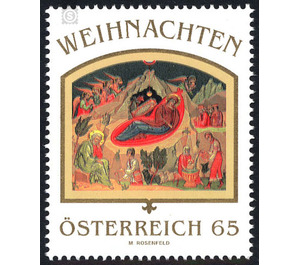Christmas - Austria / II. Republic of Austria 2007 - 55 Euro Cent
Theme: Religion & Spirituality
| Country | Austria / II. Republic of Austria |
| Issue Date | 2007 |
| Face Value | 55.00 |
| Edition Issued | 3,000,000 |
| Printing Type | Photogravure |
| Stamp Type | Commemorative |
| Item Type | Stamp |
| Chronological Issue Number | 2028 |
| Chronological Chapter | OOS-OE2 |
| SID | 350714 |
| In 49 Wishlists | |
The Christmas stamp 2007 with international tariff shows the birth of Christ on an icon from the church of St. Barbara in Vienna I. The former convict chapel of a Jesuit college, handed over to the Greek Catholic community since 1775, is today integrated into the building complex of the Austrian Post headquarters and serves the Ukrainian Greek Catholic central parish for Austria as a place of worship. The Church of St. Barbara is an example of the centuries-long bond between Austria and the Greek Catholic Church and Ukraine. The internationally renowned icon painter Prof. Svjatoslav Hordynskyj painted the pictures on the ceiling in the sanctuary and in the nave during the extensive renovation of the church from 1983-1985. These icons are executed in neo-Byzantine style with Ukrainian elements. The icon of the birth of Jesus on the left side wall in the sanctuary is committed to the traditional style in the image structure as well as in the symbolism. The center of the picture is determined by the central theme of the incarnation of God. We see the crib with the traditionally wrapped child placed in a rock cave. Orthodox iconography depicts the birth of Christ in a dark cave. In this darkness - the kingdom of Satan and death - is also the chosen people, as ox and donkey placed at the crib. And into the darkness shines the star that announces God's presence. Also present is the heavenly band of angels. From the left, the three kings approach the child, led by the angel above them. Mary lies in front of the manger like a dormant in a red shroud, the aura of the Divine. The Blessed Mother is so fully embraced by God's love. With her hand she points to the divine child on the lower right, bathed in a kind of baptismal font. In the Eastern Church, it is still the custom today to immerse the children in water at baptism. The woman with the water jug is dressed in Ukrainian tradition. On the lower left, Saint Joseph sits in a thoughtful attitude. A shepherd approaches him with his flock of sheep, asking for directions to Christ. The pomegranate tree in the middle below symbolizes the presence of the church as Ekklesia, the community of the faithful. The icon carries the theology and spirituality of the Eastern Church in itself. It becomes a work of art through the divine truth that includes it. Icons are like windows in the sky and lead the believer up to the invisible reality of the sky. They make the wonders of God visible and encourage the viewer to search for the truth and find God.


